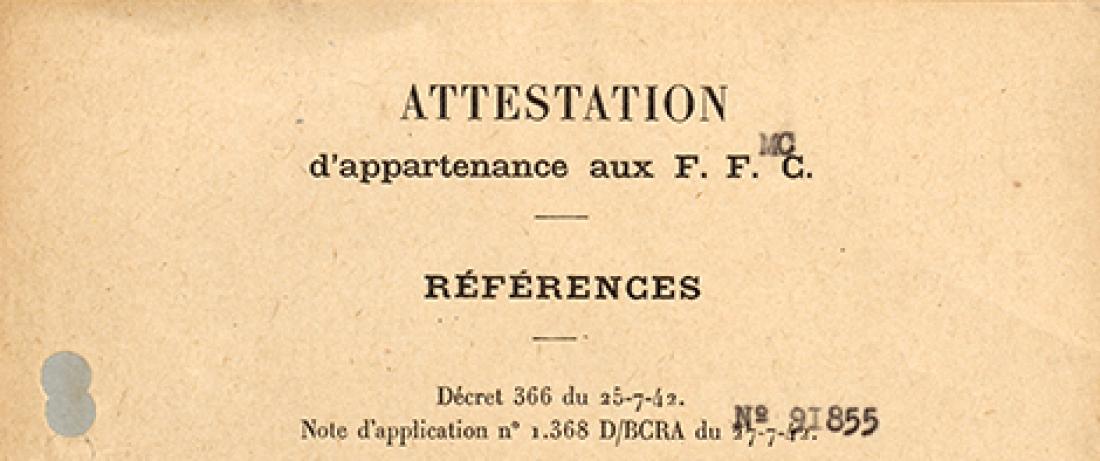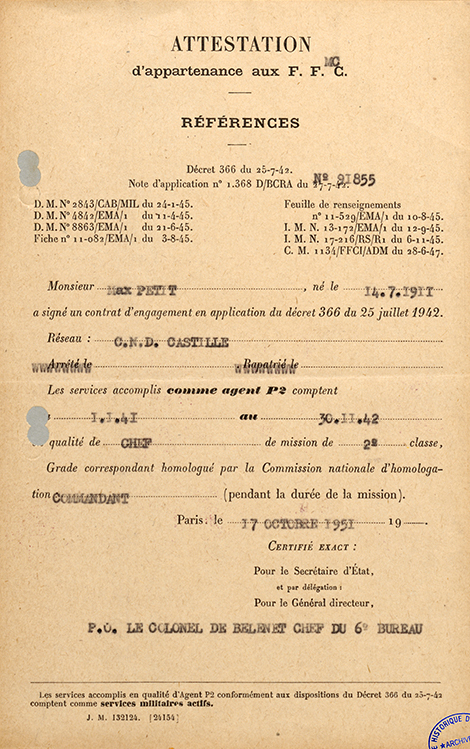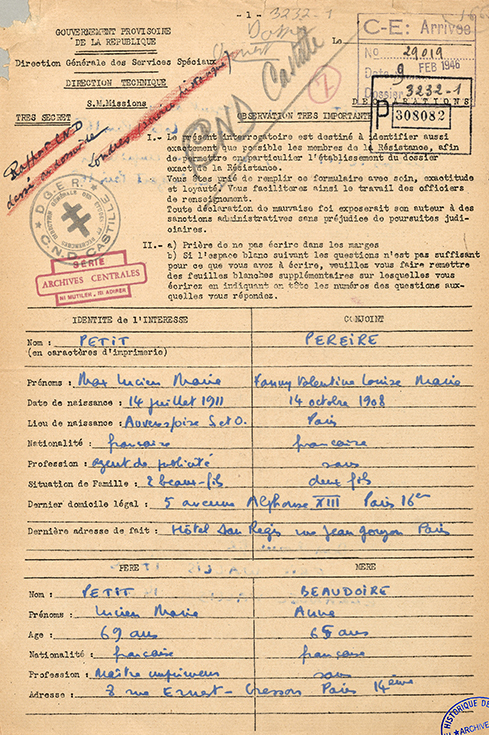1944-45 : Interrogating network agents des réseaux

When the Liberation came, it was vital to be able to identify and list the agents of the Resistance networks, retrace their actions and recognise their rights. It was also essential to check that no enemies, traitors or usurpers could sneak among them and profit from the agents who had demonstrated their commitment to preparing for the future.
Following the Liberation, the Direction de la sécurité militaire (DSM, Directorate of Military Security) tasked the 4th section (protecting agents) and its 3rd bureau (preventive counter-espionage) with collecting declarations, information and intelligence in France. This was to be done via a campaign of questioning and investigations involving former agents of the resistance networks. A 4th section branch was thus set up in each military region. Former resistance members began by completing a questionnaire several pages long, and were then interrogated by intelligence officers.
Identifying and recruiting resistance agents
The questionnaire (see slideshow) covered civil status, family composition, education and professional activity. It also included the agents' military careers: before 1939, following mobilisation and during the 1940 campaign. Then came questions about actual resistance activities. The agents had to describe the circumstances that had led them to enlist in a network, give the name of their recruiter, summarise their activity, explain the structure of the network and provide a list of other agents they had worked with (identities and multiple pseudonyms).
This campaign had three main objectives.
The first was to reconstitute the order of battle of the networks, while identifying the agents likely to benefit from the provisions of decree 366 of 25 July 1942 (see Decree 366 of 25 July 1942). Rights were dependent on the recognition of services. In this context, the information collected would be used well beyond the immediate post-war period (see slideshow).
The second goal involved counter-espionage: collecting as much information as possible for cross-referencing with the files in London and Algiers. This would make it possible to unmask any individuals who invented a past as a resistance member or traitors who had worked for the enemy and wanted to restore their reputation. This intelligence was then transmitted to the Bureau de sécurité militaire (BSM, Military Security Bureau) responsible for dealing with repression in the area.
The DSM's third goal was just as important: to ”recover” or recruit agents who had served with the Direction générale des études et recherches (DGER, Directorate General of Studies and Research), which the DSM had become part of at the end of 1944, ensuring that there were no enemy agents among them.
The French special services needed agents, in France and Germany and even elsewhere, for intelligence, operations and counter-espionage missions. Everyone was thus invited to indicate the names of safe people, known ”beyond the lines”, who would be ”likely to assist military action, either through intelligence or through operations”.
Following the interrogation, the 3rd bureau intelligence officer allocated everyone one of five ”visas” depending on his conclusions:
• Visa 1: full confidence. Can be used in a secret service.
• Visa 1a: no doubts, but does not have the necessary qualities for secret missions.
• Visa 2: no doubts, but of foreign origin.
• Visa 2b: doubts. Suspect.
• Visa 3: no confidence. Cannot be used in our services.
Extremely rich files
The people recruited by the DGER after the Liberation were mostly demobilised in summer 1945, as shown by the service reports contained in many of the files. However, some continued to work in the Service de documentation et de contre-espionnage (SDECE, Documentation and Counter-Espionage Service), and many of them were later sent to Indochina.
The Service historique de la défense (Defence Historical Service) conserved the declarations and interrogations conducted following the Liberation, classified by network, and particularly those of individuals given a visa 1 or 1a, i.e. about 7,000 intelligence network files.
Note that as well as the declarations and interrogations some of these files contain other documents, such as service records, reports, intelligence documents, correspondence etc.
This collection is thus an excellent complement to the individual reconnaissance files constituted by the Resistance certification committees and the military administration and also conserved by the Defence Historical Service (French Fighting Forces, French Interior Resistance, French Forces of the Interior, Free French Forces).
Jérôme Blondet
Archivist at the Defence Historical Service
FOR MORE INFORMATION
The intelligence agents' declarations are conserved in sub-series GR 28 P 4, including that of Max Petit, conserved under record number GR 28 P 4 35/180. His resistance member's file is conserved under record number GR 16 P 295613. The collection can be brought to the reading room.

Attestation d'appartenance aux Forces françaises combattantes de Max Petit, 17 octobre 1951.
© SHD


